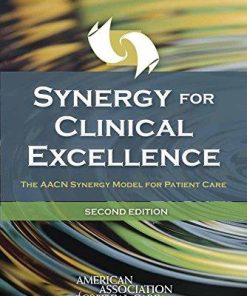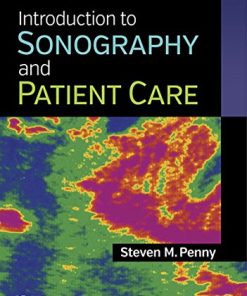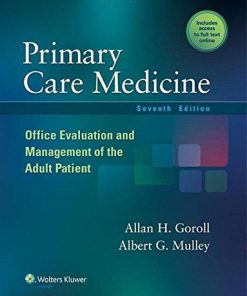(EBook PDF) Neurology and Pregnancy Pathophysiology and Patient Care 1st edition by Eric Steegers, Marilyn Cipolla, Eliza Miller 0444642919 9780444642912 full chapters
$50.00 Original price was: $50.00.$25.00Current price is: $25.00.
Neurology and Pregnancy: Pathophysiology and Patient Care 1st edition by Eric A.P. Steegers, Marilyn J Cipolla, Eliza C. Miller – Ebook PDF Instant Download/DeliveryISBN: 0444642919, 9780444642912
Full dowload Neurology and Pregnancy: Pathophysiology and Patient Care 1st edition after payment.

Product details:
ISBN-10 : 0444642919
ISBN-13 : 9780444642912
Author: Eric A.P. Steegers, Marilyn J Cipolla, Eliza C. Miller
Neurology and Pregnancy provides a comprehensive multidisciplinary guide to best practices for research and practicing neurologists, as well as obstetricians and other specialists caring for women with an acute or chronic neurological disorder. The book encompasses preconception care, genetic counseling, pregnancy in patients with chronic neurological disorders, and acute pregnancy-related neurological complications. Postpartum care and complications, including lactation concerns, are also addressed, as well as the long-term effects of pregnancy and its complications on maternal brain health.
Neurology and Pregnancy: Pathophysiology and Patient Care 1st Table of contents:
Section I: Neurophysiologic changes in pregnancy
Chapter 1: Neuroendocrine mechanisms of reproduction
Introduction
The Role of the Gonadotropin-Releasing Hormone (GnRH) “Pulse Generator´´ in Initiation and
Biosynthesis and action of GnRH
Neuroanatomy of GnRH pulse generator
Neuromodulation of the GnRH pulse generator
Neuroendocrinology of Puberty
Neuroendocrinology of the Menstrual Cycle
Follicular phase
Midcycle LH surge
Luteal phase
Functional Hypothalamic Amenorrhea/Anovulation
Pathophysiology
Behavioral contributors
Differential diagnosis
Behavioral management
Medical management
Fertility treatment in FHA
Polycystic Ovary Syndrome
Pathophysiology
Behavioral contributors
Differential diagnosis
Behavioral management
Functional Hypothalamic Hypogonadism (FHH) in Men
Pathophysiology
Behavioral contributors
Differential diagnosis
Behavioral management
Medical management
The Neuroendocrinology of Pregnancy
Summary
References
Chapter 2: Neurophysiological and cognitive changes in pregnancy
Introduction
Changes in Hormones During Pregnancy
Steroid hormones
Prolactin and placental lactogen
Changes associated with parturition
Neurophysiological Changes in the Maternal Brain
Oxytocin
Tuberoinfundibular dopamine neurons and prolactin
Adaptive Changes in Central Control of Maternal Physiology
Central adaptations of maternal energy homeostasis
Central modulation of body temperature and neuroimmune responses
Suppression of the stress response
Adaptive Changes in Behavior
Maternal behavior
Hormonal regulation of maternal behavior
Maternal aggression
Cognitive Changes
Summary and Concluding Remarks
References
Chapter 3: Adaptations in autonomic nervous system regulation in normal and hypertensive pregnancy
Introduction
Longitudinal changes in hemodynamics and hormones
Pregnancy increases SNA
Mechanisms of increased basal SNA during pregnancy
Brain sites and neurocircuitry underlying increased basal sympathoexcitation during pregnancy
Potential factors that activate central sympathetic regulatory regions during pregnancy
Gonadal steroids
Metabolic hormones: Insulin and leptin
Volume-retaining hormones (RAAS and vasopressin)
Pregnancy Impairs Baroreflex Control of HR and SNA
Potential mechanisms for attenuated baroreflex function in pregnancy
Afferent limb
Descending pathways
Medullary baroreflex pathway
Increased inhibition in the RVLM
Potential role of neurosteroid metabolite of progesterone
Potential mechanisms by which pregnancy increases basal SNA and induces sympathoexcitation, yet impa
Other reflexes altered in pregnancy
Atrial volume reflex
Arterial chemoreflex
Preeclampsia Elicits Further Increases in SNA
Preeclampsia and sympathetic overactivity
Potential mechanisms for sympathetic overactivity in preeclampsia
The sympathetic baroreflex
RAAS
AT1R-AA
Inflammation
The endothelin system
The natriuretic peptide system
Summary and Future Directions
Acknowledgments
References
Chapter 4: Physiology of the cerebrovascular adaptation to pregnancy
Introduction
Vasomotor Responses to Circulating Factors
The Cerebral Endothelium and BBB
CBF Autoregulation and Hemodynamics
Function and Structure of the Cerebrovasculature
Conclusions
References
Chapter 5: Neurobiology of maternal mental illness
Introduction
Neuroplasticity in Pregnancy
Neuroendocrinology and Immune Changes in Pregnancy
Perinatal Depression
Perinatal Anxiety and OCD
Postpartum Psychosis and Bipolar Disorder
Trauma and Posttraumatic Stress Disorder
Discussion
References
Section II: The pregnant patient: General issues in neurologic care
Chapter 6: Epidemiology of neurologic disease in pregnancy
Cerebrovascular Disease
Ischemic stroke
Hemorrhagic stroke
Preeclampsia/eclampsia
Vascular malformations and aneurysms
Subarachnoid hemorrhage
Cerebral venous sinus thrombosis
Posterior reversible encephalopathy syndrome
Reversible cerebral vasoconstriction syndrome
Cerebral autosomal dominant arteriopathy with subcortical infarcts and leukoencephalopathy
Moyamoya disease
Dissection
Epilepsy
Demyelinating Diseases
Multiple sclerosis
Neuromyelitis optica
Acute disseminated encephalomyelitis
Progressive multifocal leukoencephalopathy
Central pontine myelinolysis
Neuromuscular Disease
Neuromuscular junction disorders
Myasthenia gravis
Lambert-Eaton myasthenic syndrome
Botulism
Motor neuron diseases
Amyotrophic lateral sclerosis
Spinal muscular atrophy
Acquired muscle conditions
Inflammatory muscle disease
Hereditary neuromuscular disorders
Inherited myopathies
Myotonias
Myotonic dystrophy
Nondystrophic myotonias
Muscular dystrophy
Limb girdle muscular dystrophy
Hereditary peripheral neuropathies
Charcot-Marie-Tooth disease
Hereditary neuropathy with liability to pressure palsies
Peripheral neuropathies
Postpartum neuropathy
Femoral neuropathy
Obturator neuropathy
Lumbosacral plexopathy
Carpal tunnel syndrome
Neuralgic amyotrophy
Meralgia paresthetica
Lumbosacral radiculopathy
Other neuropathies
Diabetic neuropathy
Neuropathy due to nutritional deficiency
Autoimmune neuropathies
Acute inflammatory demyelinating polyneuropathy
Chronic inflammatory demyelinating polyneuropathy
Multifocal motor neuropathy
Headache
Primary headache disorder
Migraine
Tension-type headache
Trigeminal autonomic cephalalgias
Secondary headache disorders
Spontaneous intracranial hypotension
Idiopathic intracranial hypertension
Movement Disorders
Parkinson’s disease
Chorea
Chorea gravidarum
Wilson disease
Sydenham chorea
Myoclonus
Ataxia
Tourette syndrome
Dystonia
Stiff person syndrome
Cranial neuropathies
Bell’s palsy
Ophthalmologic Disorders
Neuro-Oncology
Pituitary tumors
Meningioma
Glioma
Choriocarcinoma
Hemangiomas
Paraneoplastic disorders
Sleep Disorders
Sleep-disordered breathing
Obstructive sleep apnea
Central sleep apnea
Narcolepsy
Restless leg syndrome
Insomnia
Parasomnias
Neurologic Infectious Disease
Bacterial meningitis
Fungal meningitis
Toxoplasmosis
Viral encephalitis
Varicella-zoster virus
Cytomegalovirus
West nile virus
Brain abscess
Infectious myelopathy
Zika virus
Neurologic Intensive Care
Irreversible brain injury
Traumatic brain injury
Spinal cord injury
Neurologic Complications of Systemic Disease
Sarcoidosis
Systemic lupus erythematosus
Psychiatric Disease
Conclusion
References
Further reading
Chapter 7: Neuro-obstetrics: A multidisciplinary approach to care of women with neurologic disease
Introduction
Preconception Care: Special Considerations
General lifestyle advice for women prior to and during pregnancy
Alcohol
Tobacco
Caffeine
Illicit drugs
Preconception risk factor assessment
Specialist Individual Preconception Care
Coordination of care
Cerebrovascular disease
Management considerations for obstetricians
Hypertension
Management considerations for neurologists
Management considerations for anesthesiologists
Epilepsy
Management considerations for obstetricians
Management considerations for neurologists
Management considerations for anesthesiologists
Demyelinating diseases
Management considerations for obstetricians
Management considerations for neurologists
Management considerations for anesthesiologists
Neuromuscular diseases
Management considerations for obstetricians
Myasthenia gravis
Myotonic dystrophy
Management considerations for neurologists
Myasthenia gravis
Myotonic dystrophy
Management considerations for anesthesiologists
Myasthenia gravis
Myotonic dystrophy
Headache
Management considerations for obstetricians
Migraine
Idiopathic intracranial hypertension (IIH)
Posterior reversible encephalopathy syndrome (PRES) and reversible cerebral vascular syndrome (RCVS)
Cerebral venous sinus thrombosis (CVST)
Management considerations for neurologists
Migraine
Idiopathic intracranial hypertension (IIH)
Posterior reversible encephalopathy syndrome (PRES) and reversible cerebral vascular syndrome (RCVS)
Neuro-oncology
Management considerations for obstetricians
Management considerations for neurologists
Management considerations for anesthesiologists
Conclusion
References
Chapter 8: Perinatal pharmacology and safety profiles
Introduction: Perinatal Pharmacology Reflects Perinatal Physiology
Maternal Pharmacokinetics
Placental Transfer and Fetal Safety
Lactation and Newborn Safety
How to Improve the Current Setting
Knowledge implementation: Translation of knowledge into practice and guidance
Knowledge generation: Structured data collection and integration
Acknowledgments and conflict•of interest
References
Chapter 9: Neuroimaging and radiation exposure in pregnancy
Introduction
Safety of Neuroimaging in Pregnancy and Lactation
Computed tomography (CT)
Deterministic effects
Stochastic effects
As low as reasonably achievable (ALARA) principle
Magnetic resonance imaging (MRI)
Safety of contrast-enhanced imaging
During pregnancy
During lactation
Radiographic Characteristics of Neurologic Conditions Associated With Pregnancy
Cerebrovascular complications
Ischemic stroke
Amniotic fluid embolism
Cerebral venous thrombosis (CVT)
Subarachnoid hemorrhage (SAH)
Preeclampsia, eclampsia, and HELLP syndrome
Posterior reversible encephalopathy syndrome (PRES)
Postpartum angiopathy (PPA)/reversible cerebral vasoconstriction syndrome (RCVS)
Demyelinating diseases of the central nervous system
Multiple sclerosis (MS)
Neuromyelitis optica spectrum disorders (NMOSD)
Neoplasms
Meningiomas
Gestational trophoblastic disease (Choriocarcinoma)
Pituitary disorders
Pituitary adenomas
Pituitary apoplexy (PA)
Sheehan syndrome (SS)
Lymphocytic hypophysitis (LH)
Back pain
Epidural processes
Others
Epilepsy
Intracranial hypotension
Wernicke’s encephalopathy
Summary
References
Chapter 10: Neuro-anesthesiology in pregnancy
Introduction
Basic Considerations Related to the Provision of Anesthesia in the Obstetric Patient
Neuraxial anesthesia
General anesthesia
Chronic Neurologic Conditions and Anesthetic Management of the Pregnant Patient Requiring Surgery
Epilepsy
Multiple sclerosis
Myasthenia gravis
Acute Neurologic Diseases That May Require Anesthetic Care in Pregnant Women
Lumbar disc herniation
Spine surgery
Neuraxial labor analgesia and cesarean delivery anesthesia
Guillain-Barre syndrome
Intracranial mass lesions
Neurosurgery (craniotomy)
Neuraxial labor analgesia and cesarean delivery anesthesia
Intracranial vascular pathology
Neurosurgery (craniotomy/embolization)
Neuraxial labor analgesia and cesarean delivery anesthesia
Stroke
Neuraxial labor analgesia or cesarean delivery anesthesia
Traumatic brain injury
Fetal and Neonatal Considerations in the Pregnant Patient Undergoing Neurosurgery
Conclusion
References
Chapter 11: Neurocritical care of the pregnant patient
Introduction
General Consideration for Neurocritical Care in the Pregnant Patient
Surgical considerations
Timing
Positioning
Diagnostic imaging
Fetal monitoring
Acute episodes
Surgical management
Antenatal steroids
Ventilation considerations
Patient location
Delivery planning
Hypertensive Disorders of Pregnancy: Preeclampsia, Eclampsia, HELLP Syndrome
Epidemiology
Diagnosis
Management
Stabilization of blood pressure
Management/prevention of eclampsia
Delivery considerations
Intracranial Neoplasms
Epidemiology
Diagnosis
Management
Medical management
Surgical management
Delivery considerations
Noneclamptic Seizures
Epidemiology
Diagnosis
Management
Supportive care
Treatment
Cerebrovascular Disorders
Epidemiology
Diagnosis
Management
General management
Ischemic stroke
Cerebral venous thrombosis
Hemorrhagic stroke
Ventriculoperitoneal Shunt Malfunction
Epidemiology
Diagnosis
Management
Shunt management
Delivery considerations
Conclusions
References
Chapter 12: Neurologic complications of medical conditions in pregnancy
Sickle Cell Disease
Neurologic manifestations
Preconception counseling
Effects of pregnancy on maternal SCD
Effects of SCD on pregnancy outcomes
Management of SCD preconception and during pregnancy
Antiphospholipid Antibody Syndrome
Etiology of the obstetric complications
Effect of APLS on pregnancy outcomes
Effects of pregnancy on neurologic complications
Management in pregnancy
Cardiac Valve Disease
Neurologic manifestations
Medications
Preconception management of women with an MHV
HIV Infection
General principles
Treatment-naïve women
Women on antiretroviral treatment
Mode of delivery and infant prophylaxis
Neurologic complications
Pregnancy outcomes
Connective Tissue Disorders
Systemic Lupus Erythematosus
Diagnosis and sex-specific concerns
Preconception management
Neurologic and psychiatric manifestations
Psychosis
Stroke
Seizures
Headache
Other neurologic manifestations
Effects of pregnancy on maternal SLE
Effects of SLE on pregnancy outcomes
Preconception planning
Fibromuscular dysplasia (FMD)
Neurologic manifestations
Summary
References
Chapter 13: The ethics of neurologically complicated pregnancies
Introduction
Ethical Theories
The four principles
Autonomy
Beneficence and nonmaleficence
Justice
Casuistry
Feminist ethics and ethics of care
Virtue ethics
Four-quadrant approach
Bioethics of pregnancy
Application of Ethical Frameworks at the Interface of Obstetrics and Neurology
Deciding for others
Determination of capacity and competence
Surrogate decision-makers and advance directives
Standards for making proxy decisions
Substituted judgment
Best interests
Advance directives in pregnancy
Reproductive Decisions in Intellectually Disabled Pregnant Women
Background
Sterilization and abortion for women with cognitive impairment
Case study
Treatment of Neurologic Conditions in Pregnancy: Shared Decision-Making
Balancing benefits and burdens of treatment options in neurologic conditions impacting maternal and
Background
Shared decision-making
Brain Death and Disorders of Consciousness in Pregnancy
Medical facts
Clarifying the medical facts: Disorder of consciousness and brain death
How should decision-making proceed?
Gestational age and fetal condition
The Ethics Committee
References
Section III: Prenatal neurologic diagnoses: Pathophysiology, diagnosis, and management
Chapter 14: The developing brain by trimester
The Developing Brain per11Abbreviations used in the chapter are listed at the end of the chapter bef
Germinal Matrix (GM)
Germinal matrix development
Germinal matrix hemorrhage (GMH)
Antenatal cystic matrix regression (germinolysis, subependymal pseudocyst)
Development of Arteries
Vasculogenesis
Phases of arterial development
Intrinsic brain vessels
Development of Veins
Initial venous development (Streeter, 1915; Padget, 1956)
Other developmental findings have clinical relevance
Primary Gyration
Normal development
Abnormal development
Gyrification theories and relation to the perinatal period
Development of White Matter (WM)
Cerebral mantle layers
Major forebrain connections
Development of Cerebellum
Cerebellar structure and function
Cerebellar development
Cerebellar malformations
Genetic defects of neurogenesis in cerebellar germinal zones
Genetic defects in migration, synaptogenesis, and connectivity
Prenatal cerebellar disruption
Prenatal cerebellar hemorrhage
Congenital cerebellar infection
Fluid Production and Ventricular Size
CSF space development
Choroid plexus development
Fetal ventriculomegaly (see also Chapter 15 of this volume)
Definition
Imaging aspects
Diagnostic testing
References
Chapter 15: Diagnosis and management of congenital neurologic disease during pregnancy
Fetal Ventriculomegaly
Midline Abnormalities
Abnormalities of the Corpus Callosum
Holoprosencephaly
Septo-Optic Dysplasia
Agenesis of the Cavum Septum Pellucidum
Posterior Fossa Abnormalities
Dandy-Walker Malformation (DWM)
Mega Cisterna Magna (MCM)
Vermian Hypoplasia (VH)/Dysgenesis
Blake’s Pouch Cyst (BPC)
Cerebellar Hypoplasia
Joubert Syndrome (JS)
Rhombencephalosynapsis (RS)
Kinked Brainstem
Neural Tube Defects (NTDs)
Anencephaly and Craniorachischisis
Myelomeningocele, Myelocele, and Meningocele
Encephalocele
Tuberous Sclerosis Complex (TSC)
Schizencephaly
Periventricular Nodular Heterotopia (PNH)
Brain Tumors
Fetal Stroke
Conclusion
References
Chapter 16: Perinatal stroke
Introduction
Gestational Cerebrovascular Development
Neonatal Cerebrovascular Development and Autoregulation of Cerebral Blood Flow
Classification of Perinatal Stroke
Perinatal arterial ischemic stroke (PAIS)
Clinical presentation
Diagnosis
Further evaluation of the neonate with PAIS
Etiology and pathogenesis
Management and treatment
Prognosis
Cerebral sinovenous thrombosis (CSVT)
Presentation
Diagnosis
Management and treatment
Prognosis
Hemorrhagic stroke
Clinical presentation and diagnosis
Etiology and pathogenesis
Management and treatment
Prognosis
Risk Factors for Perinatal Stroke
Maternal/Obstetric factors
Intrapartum events
Neonatal factors
Prothrombotic factors
People also search for Neurology and Pregnancy: Pathophysiology and Patient Care 1st:
can pregnancy cause neurological problems
is brain mri safe during pregnancy
can you get a brain mri while pregnant
what are the risks of having an mri while pregnant
neurological symptoms pregnancy
You may also like…
Medicine & Health Science
Politics & Philosophy - General & Miscellaneous Philosophy
Uncategorized
Primary Care Medicine: Office Evaluation and Management of the Adult Patient – Ebook PDF Version
Medicine - Neurology
Neurology and Pregnancy: Neuro-Obstetric Disorders 1st Edition Eric A.P. Steegers












